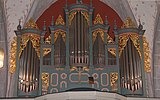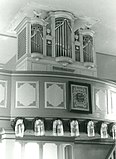Johann Stephan Heeren
Johann Stephan Heeren (baptized June 26, 1729 in Gottsbüren ; † June 10, 1804 in Höxter ) was a German organ builder.
Life
Johann Stephan Heeren was the most important representative of the organ builder dynasty in Gottsbüren, which was founded by Joachim Kohlen (1598–1676) and continued by his son David Kohlen (1640–1737) and grandson Stephan Kohl (1687–1758). Johann Stephan Heeren was the grandson of Anna Kohlen and the newcomer Christoph Heeren. On June 26, 1729, he was baptized as the son of David Heeren. When Heeren took over the company, it initially continued to operate under the name “Kohlen”. In 1765 he moved to Barntrup , but returned to Gottsbüren in the 1770s and was appointed a privileged court organ builder by Landgrave Friedrich II. Heeren. Not his eldest son Friedrich David Heeren (* October 24, 1769; † July 12, 1846) continued the business, but his son Johann Christoph (* April 3, 1775 in Gottesbüren). Heeren's daughter Anna Elisabeth married Johann Friedrich Euler on December 7, 1784 (April 19, 1759 - June 18, 1795). In the last years of his father's life, Johann Christoph worked in the workshop and took it over after his death, together with his brother-in-law Johann Dietrich Kuhlmann. The company was renamed "Heeren et Kuhlmann". After Euler's early death, Johann Dietrich Kuhlmann (around 1775–1846) married the widow and took over the workshop in 1804. Heeren's grandson Balthasar Conrad Euler joined the company from around 1815, which has now been renamed "Euler and Kuhlmann". His descendants continued the family business that existed in Hofgeismar until the 20th century and, with a total of twelve generations, is the oldest organ building company in Germany.
plant
The smaller pointed towers that directly flank the larger central tower are typical of Heeren's design. In 1756/57, instead of the usual central flat fields, Heeren designed small side pipe fields in the Zierenberg town church, which lead to the pedal towers.
List of works
| year | place | building | image | Manuals | register | Remarks | |
|---|---|---|---|---|---|---|---|
| 1756/57, 1787 | Zierenberg | City Church | I / P | 12 | 1787 extended by 5 registers by Heeren | ||
| 1774-1777 | kassel | Catholic Elisabeth Church | Not received | ||||
| 1778 | kassel | Ev. Garrison Church | Not received | ||||
| 1778-1785 | Bad Arolsen | City Church |

|
II / P | 26th | Completed in 1787; Brochure by Marcus Christoph Krau (1779–1782) | |
| 1787 | Wahmbeck | Christophoruskirche | I / p | 6th | 1863 Balthasar Conrad Euler added two pedal stops; receive | ||
| 1787 | Veckerhagen | Ev. church | Prospectus received | ||||
| 1788 | Will bath food | St. Liborius | Rebuilt several times | ||||
| 1791 | Varlose | St. Michael |

|
I / P | 12 | 2 manual registers can also be used alternatively (by changing loops) in the pedal; receive | |
| around 1792 | Löwenhagen | Ev.-luth. church | I / P | 14th | receive | ||
| 1795 | Lenglern | St. Martini |

|
I / P | 13 | receive | |
| 1797 | Benterode | Village church | I / P | 13 | 2 manual registers can also be used alternatively (by changing loops) in the pedal; Prospectus received | ||
| 1798 | Oberelsungen | Ev. church | I / P | 13 | receive | ||
| 1799 | Lippoldshausen | Village church | |||||
| around 1800 (1797?) | Landwehrhagen | Ev.-luth. Petrikirche | I / P | 16 | After the church was rebuilt in 1824, it was rebuilt by Johann Dietrich Kuhlmann; 2004 restored by Bosch; receive | ||
| 1799-1800 | Adelebsen | St. Martini | I / P | 14th | Together with Johann Dietrich Kuhlmann; receive | ||
| 1804 | Beverungen | ?? |
The attributions in Alverdissen , where a small work (I / 7) was created around 1800, and Herlinghausen are not certain .
literature
- Dieter Großmann: organs and organ builders in Hessen . 2nd Edition. Trautvetter & Fischer, Marburg 1998, ISBN 3-87822-109-6 (contributions to Hessian history 12).
- Hans Römhild: Germany's oldest organ building company . In: Hessian homeland . tape 17 , no. 4 , 1967, p. 110-116 .
- Eckhard Trinkaus, Gerhard Aumüller : Organ building in the Waldeck-Frankenberg district . In: Friedhelm Brusniak, Hartmut Wecker (ed.): Music in Waldeck-Frankenberg. Music history of the district . Bing, Korbach 1997, ISBN 3-87077-098-8 , pp. 144-202 .
- Eckhard Trinkaus: organs and organ builder in the former district of Ziegenhain (Hesse) . Elwert, Marburg 1981, ISBN 3-7708-0713-8 (publications of the Historical Commission for Hesse 43).
See also
Web links
- Organ Atlas Ostwestfalen-Lippe: Westphalian organ builders active in Westphalia
- Diocese of Fulda: Euler family of organs (PDF file) (13 kB)
Individual evidence
- ^ Dieter Großmann: Organs and Organ Builders in Hesse (= contributions to Hessian history 12 ). 2nd Edition. Trautvetter & Fischer, Marburg 1998, ISBN 3-87822-109-6 , pp. 73 .
- ↑ Hans-Werner Coordes: Organ Atlas Ostwestfalen-Lippe: Westphalian organ builders active in Westphalia , seen April 10, 2011.
- ^ Eckhard Trinkaus, Gerhard Aumüller : Organ building in the Waldeck-Frankenberg district . In: Friedhelm Brusniak, Hartmut Wecker (ed.): Music in Waldeck-Frankenberg. Music history of the district . Bing, Korbach 1997, ISBN 3-87077-098-8 , pp. 332 .
- ^ Gerhard Aumüller, Mads Kjersgaard, Wolfgang Wagner: Considerations on the origin of the organ in Brevörde . In: Ars Organi . 4/2006, p. 225 f.
- ↑ Diocese of Fulda: Euler family of organs (PDF file) (13 kB), viewed April 10, 2011.
- ^ Eckhard Trinkaus: organs and organ builders in the former district of Ziegenhain (Hesse) (= publications of the Historical Commission for Hesse 43 ). Elwert, Marburg 1981, ISBN 3-7708-0713-8 , pp. 332 .
- ^ Eckhard Trinkaus, Gerhard Aumüller: Organ building in the Waldeck-Frankenberg district . In: Friedhelm Brusniak, Hartmut Wecker (ed.): Music in Waldeck-Frankenberg. Music history of the district . Bing, Korbach 1997, ISBN 3-87077-098-8 , pp. 190 .
- ^ Hans Römhild: Germany's oldest organ building company . In: Hessian homeland . tape 17 , no. 4 , 1967, p. 110-116 .
- ^ Dieter Großmann: Organs and Organ Builders in Hessen . 2nd Edition. Trautvetter & Fischer, Marburg 1998, ISBN 3-87822-109-6 , pp. 73 f . (Contributions to Hessian history 12).
- ↑ Veckerhagen parish (with illus.), Viewed October 20, 2019.
- ↑ " The current local church, in which there is a new organ with 10 parts in the manual and 4 parts in the pedal together with a pedal coupler, was built by Lieutenant Colonel von Stockhausen for his money in 1792, the local community taking over the transport and hand services . " (Münden ephoral archive in the Göttingen church district archive, Specialia Löwenhagen, A 333)
- ^ Orgelbau Bosch: Ev. Lutheran Church Benterode , seen October 20, 2019.
- ↑ The undated " .. Disposition of the new organ, which determines the Church Landwerhagen, and H. von of local community with the organ builder armies to 520 Rthl currt M. accordirt is ", containing only 14 registers; but since it is said in 1818 that the organ cost " 800 Thaler ", the number of registers may have been increased while it was being built. (Münden ephoral archive in the Göttingen church district archive, Specialia Landwehrhagen A 511 and A 513.1)
- ^ Orgelbau Bosch: Ev. Lutheran Petrikirche Landwehrhagen , seen October 18, 2019.
- ↑ The Protestant congregation in Beverungen was only founded in 1854, and its church was not even built until 1866. The organ case in the local Catholic church , however, dates from around 1700. It is therefore unclear where Heeren should have built an organ here. - A repair or rebuilding of the organ in the Catholic Church would be conceivable.
- ^ Hans-Werner Coordes: Organ Atlas Ostwestfalen-Lippe: Organ in Alverdissen , seen April 10, 2011.
- ^ Regional Association Westphalia-Lippe, Hanseatic City of Warburg (ed.): City of Warburg (= monuments in Westphalia . Volume 1.1 ). Michael Imhof Verlag, Petersberg 2015, ISBN 978-3-7319-0239-3 . , P. 434
| personal data | |
|---|---|
| SURNAME | Heeren, Johann Stephan |
| BRIEF DESCRIPTION | German organ builder |
| DATE OF BIRTH | June 26, 1729 |
| PLACE OF BIRTH | Gottsbüren |
| DATE OF DEATH | June 10, 1804 |
| Place of death | Höxter |



